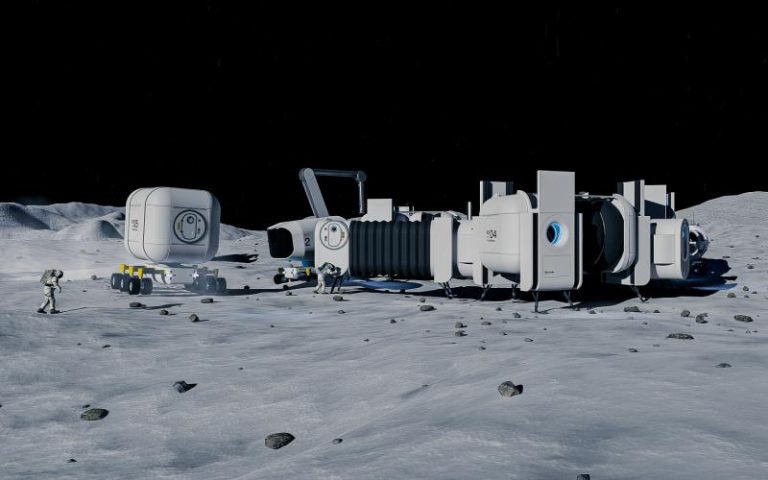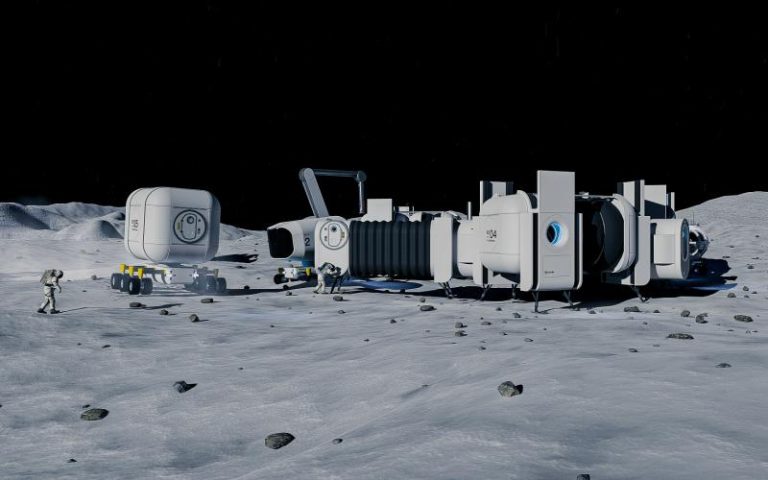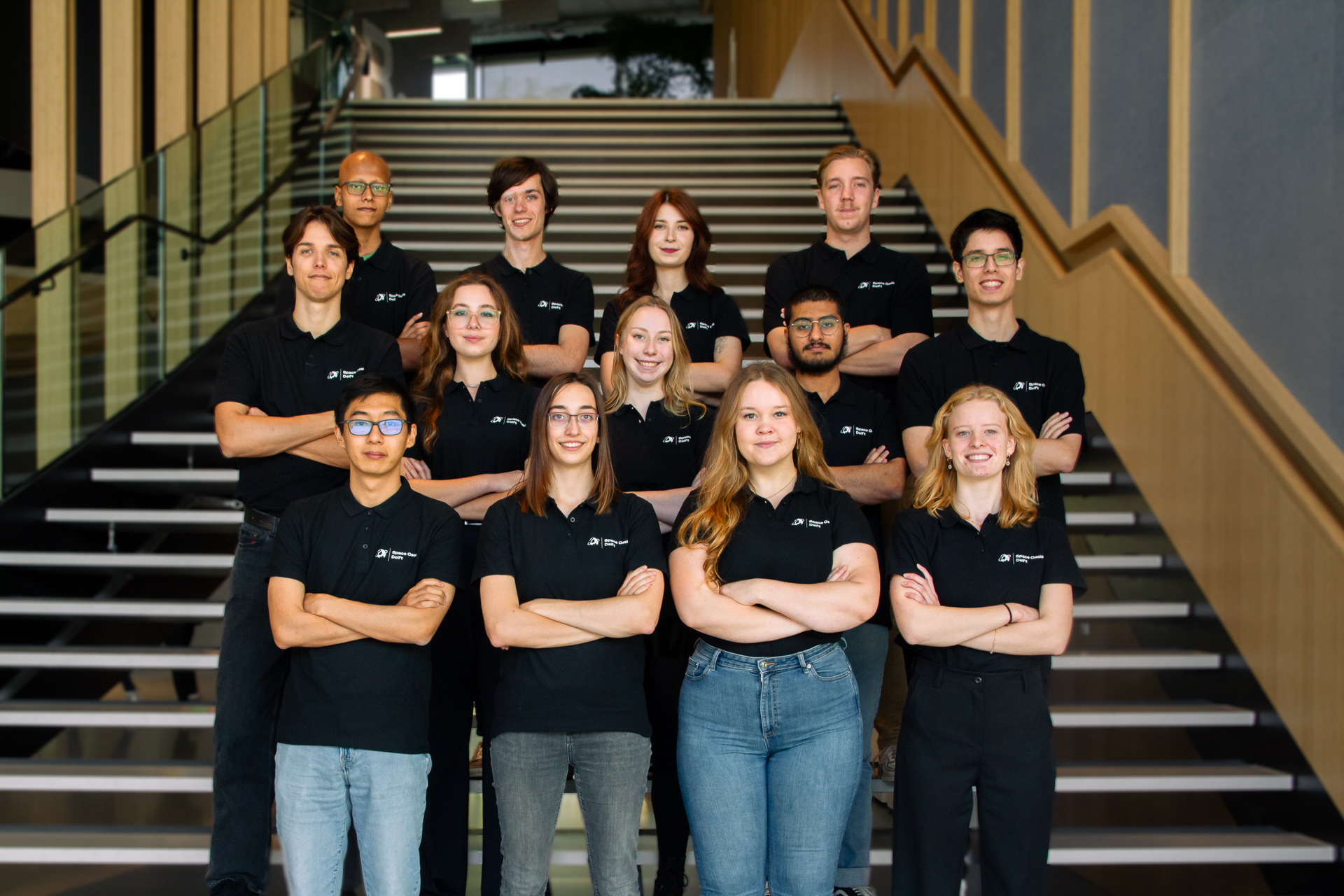New Dream Team Space Oasis Delft is designing a ‘lunar village’ as an entry for the Architecture and Innovation for Space International Grand Prix (IGP).
The Space Oasis Delft team posing on a grand staircase. (Photo: Laura ter Horst)
 Rendering of a lunar village named MoLunAr designed for the IGP by Turkish architects Sanem Bakan and Mehmet Caferoglu. (Photo: Sanem Bakan)
Rendering of a lunar village named MoLunAr designed for the IGP by Turkish architects Sanem Bakan and Mehmet Caferoglu. (Photo: Sanem Bakan) The Earth as seen from the surface of the moon, in NASA’s famous ‘Earthrise’ photograph.
The Earth as seen from the surface of the moon, in NASA’s famous ‘Earthrise’ photograph.English only
Space Oasis Delft (SOD) is the new Dream Team that seeks to compete in the IGP, a space architecture competition run by the Jacques Rougerie Foundation, in the ‘Lunar or Martian village’ category. This academic year they will be crafting their entry, a conceptual lunar habitat.
Moon dreams
After completing her BSc at the Faculty of Architecture last summer, Founder and Team Manager Marit Vegt decided that she wanted to take a break from academia to explore her growing interest in space architecture. She came up with the idea to start a student team. It is required that Dream Teams enter a contest and the IGP seemed like a perfect fit. After many months of work, she managed to persuade several other space-obsessed student ‘dreamers’ to join her. SOD was officially accredited early this academic year, and has just finished renovating their workspace and making it their own. Next up is that big ol’ block of cheese in the sky.
 Space Oasis Delft in their new workspace. They assure me the portrait of Emperor Musk is an inside-joke. (Photo: Oscar Greenwell)
Space Oasis Delft in their new workspace. They assure me the portrait of Emperor Musk is an inside-joke. (Photo: Oscar Greenwell)
The purpose of the competition is to propose self-sufficient living systems independent of the Earth, using in-situ resources. These closed-loop life-support systems must include the regulation of the atmosphere, production of food and water, and the recycling of waste, among other amenities necessary for healthy human life.
In 2015, Jan Wörner, Director General of the European Space Agency (ESA), proposed the idea of a ‘Moon village’. In line with his vision, the lunar village designed by SOD will have to be a sustainable project supporting international science, offering new opportunities for cooperation with organisations in space and on Earth, open to all nations, and offering broad potential uses, whether industrial, commercial, touristic, educational or cultural.
Similar to how NASA’s space programme led to the development of commonplace technologies, the challenge of creating a self-sustaining habitat in an extremely inhospitable environment is expected to lead to useful technological developments. Vegt adds “we want to show the world how interesting this field can be, and that we can use this science to improve life on Earth”.
2030, A Lunar Odyssey
A ‘lunar village’ seems like something that could only exist in science fiction, or decades in the future, but in fact, ESA has plans to create the first Moon base by 2030. Though this is a far-cry from a ‘village’ of up to hundreds of people, as expected by the competition judges.
TU Delft is not the only university that sees value in such endeavours – MIT’s famous Media Lab in the USA (founded in 1985) worked on its own ‘Moon village’. Hundreds of other universities and individuals from all corners of the world have submitted entries to the IGP over its decade-long lifespan.
 Rendering of a lunar village named MoLunAr designed for the IGP by Turkish architects Sanem Bakan and Mehmet Caferoglu. (Photo: Sanem Bakan)
Rendering of a lunar village named MoLunAr designed for the IGP by Turkish architects Sanem Bakan and Mehmet Caferoglu. (Photo: Sanem Bakan)
Location, location, location
The Moon is regularly bombarded by meteorites, and its pock-marked surface is covered with fine dust. The gravity is just a sixth of that on Earth. What’s more, because the Moon is in a geosynchronous orbit, one side is always facing towards our homeworld. This leads to day and night cycles that are very different than what we’re used to, with ‘nighttime’ lasting half an Earth month and ‘daytime’ lasting the other half. The hardest challenge, though, explains Chief Architect of SOD Tom van Beek is the absence of a protective atmosphere.
There is thus no attenuation of solar radiation during the day, leading to immense heat, and conversely, there is no atmosphere to ‘hold’ on to the heat at night. This creates massive variability in surface temperatures between daytime and nighttime. One of the first challenges for the fledgling Dream Team is picking a suitable location for the village where temperatures aren’t as variable. The climate is more equable away from the equator, towards the poles, and there are also craters and other geological formations that can provide a shield from sunlight. Van Beek clarifies “We tried to get our temperature difference under 200 degrees Celsius – so you know the scale we’re talking about.”
Another less obvious harsh element of the Moon is the psychological difficulty of being away from humankind en masse. Van Beek adds “a side facing the Earth is preferable as it allows for a stronger psychological connection to our home planet.”
 The Earth as seen from the surface of the moon, in NASA’s famous ‘Earthrise’ photograph.
The Earth as seen from the surface of the moon, in NASA’s famous ‘Earthrise’ photograph.
Connecting faculties
Tackling these challenges requires a deeply interdisciplinary student team. Despite being composed of less than 20 people, there are several different departments within SOD: architects will design the actual habitat; the medical department needs to consider human physiology and psychology; the engineering department needs to make sure the architectural plans are structurally feasible; and of course, the 3d rendering department needs to bring the conceptual designs to life artistically speaking.
There is also the partnerships department engaged in the crucial role of attaining funding and mentorships from companies and academics. And lastly, the public relations department which naturally focuses on public outreach and graphic design.
The novelty of SOD lies in the fact that it is an architecture-based Dream Team. Although such an interdisciplinary project requires members from different swathes of academia, the team is helmed by architects.
Vegt elucidates. “The Architecture and the Built Environment Faculty stands quite on its own at TU Delft, and we’re really connecting it with the different faculties.” Laura ter Horst, Operations Manager, chimes in. “I’ve just finished my BSc in Industrial Design Engineering, a very different field, but I really loved the idea of joining a Dream Team that’s so unique.”
Another novel aspect of the team is that it isn’t aiming for a clear goal or finish line. The judging of the competition is much more subjective. Marit notes “we are designing for human life and all its facets, not for a race. That being said, we are still of course trying to win”.
-
- If you’re interested in joining Space Oasis Delft, there are many positions still available. Contact them via their website.
Oscar Greenwell / Editor



Comments are closed.